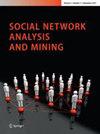The effect of the Katz parameter on node ranking, with a medical application
IF 2.3
Q3 COMPUTER SCIENCE, INFORMATION SYSTEMS
引用次数: 0
Abstract
Abstract The Medical Extensible Dynamic Probabilistic Risk Assessment Tool (MEDPRAT), developed by NASA, is an event-based risk modeling tool that assesses human health and medical risk during space exploration missions. The Susceptibility Inference Network (SIN), a sub-element of MEDPRAT, is a prototype model informed with data that represents the probabilities of medical conditions progressing from one to another and the expected quality time lost associated with the disease progression for each condition. The work presented in this paper aims to determine which conditions in the SIN have the greatest effect on MEDPRAT-predicted medical risk. Here, we propose to measure this expected quality time lost using a weighted version of Katz centrality and investigate the effect of the $$\alpha$$Katz参数对节点排序的影响,并以医学应用为例
医学可扩展动态概率风险评估工具(MEDPRAT)是美国国家航空航天局(NASA)开发的一种基于事件的风险建模工具,用于评估太空探索任务中人类健康和医疗风险。易感性推断网络(SIN)是MEDPRAT的一个子元素,是一个原型模型,它的数据代表了医疗状况从一种发展到另一种的概率,以及每种状况与疾病进展相关的预期质量时间损失。本文提出的工作旨在确定SIN中的哪些条件对medprat预测的医疗风险影响最大。在这里,我们建议使用Katz中心性的加权版本来测量这种预期质量时间损失,并研究$$\alpha$$ α参数对行走长度的影响,这显著影响节点的排名。为了做到这一点,我们引入了一个工具来比较不同的中心性度量的节点排名。这个通用工具是独立的,因为它认为,如果两个节点的分数在误差范围内,通过中心性度量对两个节点的相对排名是不可靠的。特别是,我们找到了一个行走长度的上界,它决定了节点在这个误差范围内的排名。如果应用程序对可能的行走长度施加了实际的限制,那么这组工具可以帮助确定$$\alpha$$ α的合适值。
本文章由计算机程序翻译,如有差异,请以英文原文为准。
求助全文
约1分钟内获得全文
求助全文
来源期刊

Social Network Analysis and Mining
COMPUTER SCIENCE, INFORMATION SYSTEMS-
CiteScore
5.70
自引率
14.30%
发文量
141
期刊介绍:
Social Network Analysis and Mining (SNAM) is a multidisciplinary journal serving researchers and practitioners in academia and industry. It is the main venue for a wide range of researchers and readers from computer science, network science, social sciences, mathematical sciences, medical and biological sciences, financial, management and political sciences. We solicit experimental and theoretical work on social network analysis and mining using a wide range of techniques from social sciences, mathematics, statistics, physics, network science and computer science. The main areas covered by SNAM include: (1) data mining advances on the discovery and analysis of communities, personalization for solitary activities (e.g. search) and social activities (e.g. discovery of potential friends), the analysis of user behavior in open forums (e.g. conventional sites, blogs and forums) and in commercial platforms (e.g. e-auctions), and the associated security and privacy-preservation challenges; (2) social network modeling, construction of scalable and customizable social network infrastructure, identification and discovery of complex, dynamics, growth, and evolution patterns using machine learning and data mining approaches or multi-agent based simulation; (3) social network analysis and mining for open source intelligence and homeland security. Papers should elaborate on data mining and machine learning or related methods, issues associated to data preparation and pattern interpretation, both for conventional data (usage logs, query logs, document collections) and for multimedia data (pictures and their annotations, multi-channel usage data). Topics include but are not limited to: Applications of social network in business engineering, scientific and medical domains, homeland security, terrorism and criminology, fraud detection, public sector, politics, and case studies.
 求助内容:
求助内容: 应助结果提醒方式:
应助结果提醒方式:


